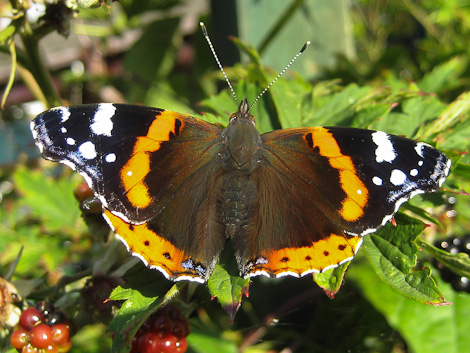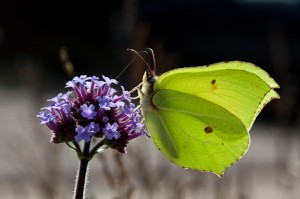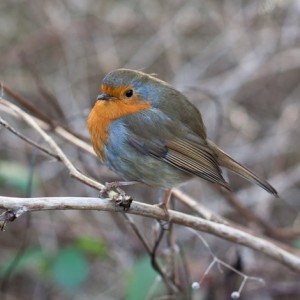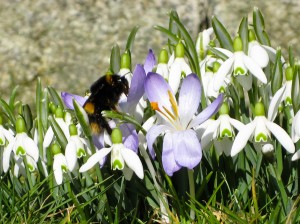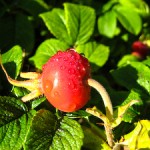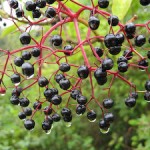Snails – curse of gardeners everywhere, something to try and remove at all costs, and dull, dull dull. As my mother would say, what use are they to anyone? Until recently I was of a similar opinion. I tried to remove them from the garden, tried to encourage hedgehogs in to help do away with them, watered nematodes around my crops (although I admit this was more to deal with slugs than snails) and generally wondered if there was anything good to say about them.
However, a few months ago I started my photography 366 project which involves taking a different photo each day. When out for an evening wander I came across lots of snails making their way across the footpath and spent far too long trying to take photos of them. I was struck by how varied they were and by the number of different colours and patterns. Being me I decided to do some research, the first port of call was my newly purchased copy of Bugs Britannica. This then led me to the internet and a new appreciation of these snails.
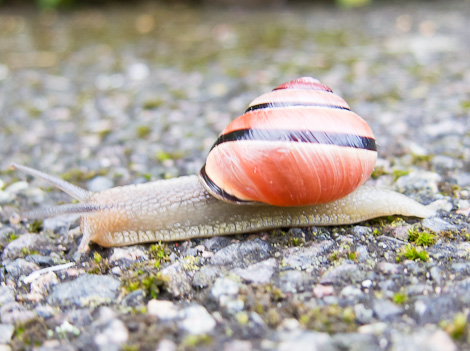 So, to start with, these are banded snails – there are brown lipped and white lipped varieties (although to add to the confusion young brown lipped snails have a white lip). To set the record straight, in common with many slugs, it appears that these snails feed mainly on decaying vegetation. So, although they will munch on my french beans, it seems that the garden snail is a bigger criminal.
So, to start with, these are banded snails – there are brown lipped and white lipped varieties (although to add to the confusion young brown lipped snails have a white lip). To set the record straight, in common with many slugs, it appears that these snails feed mainly on decaying vegetation. So, although they will munch on my french beans, it seems that the garden snail is a bigger criminal.
The variation in colouration and banding pattern also means that they are one of the most genetically studied creatures around, that and the fact that they can be found pretty much everywhere. They come in three colour varieties – brown, pink and yellow and have varying amounts of banding – as illustrated in these photos. This was a basis for a huge online citizen science project carried out in 2009.
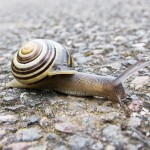 The basis of the project was to compare distributions of the yellow and brown snails and different amounts of banding – unbanded, mid-banding, lots of banding. Observations were made across Europe and compared to historical records. The reason behind the project was to see if the increase in temperature of 1.3oC in the latter half of the twentieth century had affected the distribution of the variations. This is because of the ‘albedo’ effect – which is a measure of the reflectivity of a surface. The theory was that as the climate got warmer there would be an increase in the number of yellow-shelled snails compared to the darker variants and an increase in the proportion of unbanded snails as they evolved to stay cooler.
The basis of the project was to compare distributions of the yellow and brown snails and different amounts of banding – unbanded, mid-banding, lots of banding. Observations were made across Europe and compared to historical records. The reason behind the project was to see if the increase in temperature of 1.3oC in the latter half of the twentieth century had affected the distribution of the variations. This is because of the ‘albedo’ effect – which is a measure of the reflectivity of a surface. The theory was that as the climate got warmer there would be an increase in the number of yellow-shelled snails compared to the darker variants and an increase in the proportion of unbanded snails as they evolved to stay cooler.
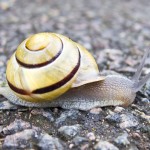 So, what was the result. They separated out the results according to habitat – sand dunes, grassland, hedges and woodland. It was only in the sand dune areas that the proportion of yellow snails increased – in the other areas it would appear that there was sufficient shade and moisture that the increase in global temperature had no effect. In fact a higher proportion of yellow snails were found in the sand dunes compared to the brown and banded snails and there was a decrease in frequency of the yellow snails as the amount of shading available increased; the smallest proportion being found in woodlands.
So, what was the result. They separated out the results according to habitat – sand dunes, grassland, hedges and woodland. It was only in the sand dune areas that the proportion of yellow snails increased – in the other areas it would appear that there was sufficient shade and moisture that the increase in global temperature had no effect. In fact a higher proportion of yellow snails were found in the sand dunes compared to the brown and banded snails and there was a decrease in frequency of the yellow snails as the amount of shading available increased; the smallest proportion being found in woodlands.
With regards to the banding the conclusion was that the data was inconclusive! There is the potential that changes are linked to habitat and predation. As their main predator is the song thrush then changes in the distribution of the song thrush may have an effect. Changes in the habitat that are not easily captured by the survey data may also be responsible for changes. Other things may have an effect… It appears that the banded snail is retaining an element of mystery for further study.
Tag: Nature
Migrant Butterflies
When you think of migrant species, the word butterfly is not usually the first thing that pops into your head. Whilst many of us have seen pictures of the mass migrations of Monarch butterflies in America, you may not realise that many of the butterflies that we see in our gardens each year have flown in from Europe or Africa. (Although the recent coverage of the Painted Lady migrations on the fantastic Springwatch may have increased awareness of migratory butterflies.)
More surprising though is the fact that one of our commonest butterflies, the Red Admiral, is a migrant. To confuse things still further though, it is also in some cases being classed as a resident. Climate change and the warmer winters means that it is now able to survive winters as an adult in the south of the country (this includes Northamptonshire). Consequently it is often one of the first butterflies seen each year – often in January.
The Red Admiral is a striking and unmistakeable butterfly. Its Latin name is Vanessa Atalanta, named after the beautiful and athletic goddess Atalanta, a famous huntress. Atalanta tried to enlist with the argonauts but was turned down as Jason was worried about the presence of one woman on the ship. She would go to such lengths to avoid marriage that suitors were challenged to a race, those who lost, the penalty not being a sufficient deterrent, being put to death. She was eventually beaten after the love goddess Aphrodite took pity on a suitor and helped him distract Atalanta during the race.
The butterfly given her name can be seen throughout the year (although the first major migration occurs from mid-May to the end of June), in most habitats, throughout the country. It will visit many flowers, switching from one favourite to another as the summer progresses, moving onto fruit and then ivy blossom in the autumn. There would usually be a return migration in the autumn, but they are increasingly staying to overwinter in the south of England.
The food plant of the Red Admiral is the nettle, with the small, green egg laid on the upperside of a leaf. When this hatches, the caterpillar uses silk to form a tent from the leaf on which it hatched, and, as it grows it pulls in more leaves to its tent and eventually makes its chrysalis in the tent. After two and half weeks the black or yellow spiny caterpillar will emerge from its chrysalis as a stunning red, white and black butterfly.
More Spring Flowers
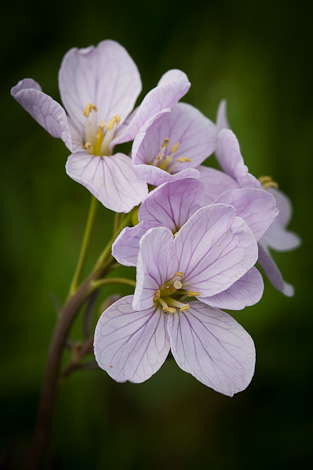 From April through to June you might see masses of white flowers in the churchyard, along hedgerows or in damp meadows (there are usually lots at the bottom of the dam in Daventry Country Park). If you get closer you will see that these are not white flowers, but very pale pink or lilac. These are cuckoo flowers or lady’s smock (they are also called milk maids, bittercress, mayflower, meadowcress and pigeon’s eye in various parts of the country). Their name originates from the coincidence of their flowering time with the call of the first returning cuckoos from their African wintering grounds. The name lady’s smock dates from the Tudor period due to the resemblance of the flowers to the smocks worn at the time. Possibly originating from this time is also the belief that it is unlucky to bring a cuckoo flower into the house.
From April through to June you might see masses of white flowers in the churchyard, along hedgerows or in damp meadows (there are usually lots at the bottom of the dam in Daventry Country Park). If you get closer you will see that these are not white flowers, but very pale pink or lilac. These are cuckoo flowers or lady’s smock (they are also called milk maids, bittercress, mayflower, meadowcress and pigeon’s eye in various parts of the country). Their name originates from the coincidence of their flowering time with the call of the first returning cuckoos from their African wintering grounds. The name lady’s smock dates from the Tudor period due to the resemblance of the flowers to the smocks worn at the time. Possibly originating from this time is also the belief that it is unlucky to bring a cuckoo flower into the house.
These are a perennial, native plant with yellow-centred flowers (which close up at night and in heavy rain) held on thin stalks that are usually about a foot in height (although they can grow to twice that height). Their small kidney-shaped leaves are rich in Vitamin C and were used to fight against scurvy. Although it has been used in salads when lettuce was not available, it hasn’t gained the popularity in modern times of its close relative, watercress.
It is however much prized by the caterpillars of both the orange tip and green veined white butterflies. In fact, one of the easiest ways to see the orange tip butterflies is to find a hedgerow containing cuckoo flowers and, if it is a sunny day, it probably won’t be long before you see a male orange tip butterfly patrolling by.
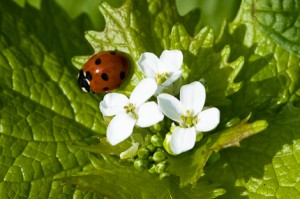 Another plant that is seen in hedgerows alongside the cuckoo flower is garlic mustard. Like most flowers this one also has numerous other names, the most common being jack-by-the-hedge, although it is also known as Garlic Root, Hedge Garlic, Sauce-alone, Jack-in-the-bush, Penny Hedge and Poor Man’s Mustard.
Another plant that is seen in hedgerows alongside the cuckoo flower is garlic mustard. Like most flowers this one also has numerous other names, the most common being jack-by-the-hedge, although it is also known as Garlic Root, Hedge Garlic, Sauce-alone, Jack-in-the-bush, Penny Hedge and Poor Man’s Mustard.
This is a much taller, more erect plant than the cuckoo flower growing up to about a metre in height. In the first year there are rosettes of green leaves close to the ground. These overwinter and throw up strong, tall stems. Between April and June there are clusters of small white flowers, each with four petals arranged in a cross shape. These then form seed pods which are about four centimetres long that burst open in mid July scattering shiny black seeds up to a metre around.
The name derives from the smell of garlic when the leaves are bruised and, like the cuckoo flower its leaves (and sometimes flowers and seeds) have been added to salads. In this case they are said to taste of both garlic and mustard.
It has also been used medicinally as a diuretic, disinfectant and to treat gangrene, ulcers and sore throats.
It was introduced to North America in the 1860s and is now considered and invasive species (depending on conditions it can self pollinate and the seeds can lay dormant for a couple of years). In some areas it is threatening native butterflies which confuse it with food plant of their caterpillar. They then lay their eggs on the garlic mustard, but the caterpillars cannot eat the leaves and therefore don’t survive.
In the UK it is an important food plant for the caterpillars of the orange-tip and green-veined white butterflies, as well as supporting many other native insects. Its seeds are also important in the diet of farmland birds.
Flutterby Butterfly – look out for these beautiful insects this spring
One of the first butterflies that you will notice as the days get a bit warmer and lighter is the Brimstone. As its name suggests this is a yellow butterfly, which it is thought was the original butter-coloured fly from which butterfly was derived – its name later being changed to reflect its sulphurous colour.
The Brimstone is one of the few UK butterflies that overwinter as an adult and therefore it is one of the early fliers in Spring. In fact Brimstones were spotted on 2nd January in Hampshire and Surrey, and have already been spotted in Northamptonshire in February.
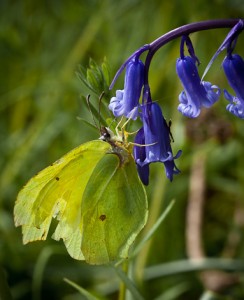 Whilst many butterflies live as adults for only a few weeks Brimstones are a much longer-lived insect and, despite laying eggs only once a year, can be seen from February through to November, depending on where you are in the country. The best time to see the butterflies are reported to be April, May and August (the latter when the year’s eggs have gone through their full cycle and the adults have emerged). However, I think they are much more noticeable in March when there are fewer insects about and the bright yellow of their wings becomes very noticeable as it catches the spring sunshine. They are another of the indicator species that I use to decide that spring has finally sprung.
Whilst many butterflies live as adults for only a few weeks Brimstones are a much longer-lived insect and, despite laying eggs only once a year, can be seen from February through to November, depending on where you are in the country. The best time to see the butterflies are reported to be April, May and August (the latter when the year’s eggs have gone through their full cycle and the adults have emerged). However, I think they are much more noticeable in March when there are fewer insects about and the bright yellow of their wings becomes very noticeable as it catches the spring sunshine. They are another of the indicator species that I use to decide that spring has finally sprung.
So, how do you recognise a Brimstone butterfly and where will you see one? The males are a bright yellow colour whereas the females are much paler but both have an orange spot on their wings; their colour makes them unmistakeable in flight. They are a medium sized butterfly, their wings are about 2 1/4 inches and they are very strong fliers, often roaming away from their food sources in search of a mate.
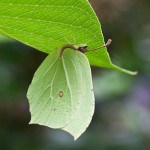 At rest you will notice that their wings are a beautiful leaf or shield shape. This helps them camouflage themselves for roosting overnight under ivy leaves or for when hibernating over winter. I was actually surprised by how well they blend in when I watched one move underneath the leaf of a dogwood in the garden to shelter from the rain.
At rest you will notice that their wings are a beautiful leaf or shield shape. This helps them camouflage themselves for roosting overnight under ivy leaves or for when hibernating over winter. I was actually surprised by how well they blend in when I watched one move underneath the leaf of a dogwood in the garden to shelter from the rain.
Brimstone caterpillars eat mainly buckthorn and alder buckthorn plants, they are bright green and apparently resemble the caterpillars of the cabbage white butterflies. I haven’t seen any yet, but I will let you know if I find some.
They are found almost anywhere there is a bit of sunshine. Males can be seen patrolling along hedgerows and roadside looking for love, whereas the females tend to be a little less obvious and hide in the vegetation. They are particularly fond of purple and nectar rich plants. In the spring you will often see them on primroses, cowslips and bluebells, whereas in the summer knapweed, teasel (which their long proboscis allows them to feed on) and thistles are popular. The Brimstones that I have seen in my garden tend to like the buddleia and verbena- as do most of the other insects.
So, in the coming month, keep an eye out for this remarkably pretty butterfly. If you see it, you will know spring is on its way.
If you want to know more about butterflies or help conserve them then the Butterfly Conservation website is a good place to start.
Volunteers wanted to join World’s largest wildlife survey from the comfort of their own home.
This weekend (28th and 29th January) sees the next instalment of the world’s largest wildlife survey. The RSPB has been running the annual check on the state of garden birds each year for 33 years. It started life as a survey done by members of its Young Ornithologists Club before being made open to all. Last year the Big Garden Birdwatch had 609,177 participants who saw a grand total of 10,262,501 birds.
So, why is the Big Garden Birdwatch important? Each year it provides a snapshot of the status of the more common birds that we see every day (and some not so common birds) and, because so many people take part it gives a good average for the UK as a whole. Over the years it has highlighted the reduction in common birds such as house sparrows and starlings, which, although spotted by a large proportion of the public are not around in the same numbers as they used to be.
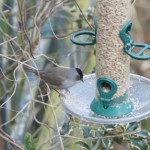 It also highlights when different bird species start visiting gardens in bigger numbers. One year may be an anomaly, several years establishes a trend. Recent increases have been seen from long-tailed tits, bullfinches and goldfinches, mainly due to the increase in bird food types offered by those feeding the birds.
It also highlights when different bird species start visiting gardens in bigger numbers. One year may be an anomaly, several years establishes a trend. Recent increases have been seen from long-tailed tits, bullfinches and goldfinches, mainly due to the increase in bird food types offered by those feeding the birds.
A third reason that the birdwatch is important is that it has highlighted changes in migration patterns such as blackcaps which rarely overwintered a few years ago, but are now regularly spotted in gardens in Winter (in fact I have had one visiting my birdfeeders every year for three years).
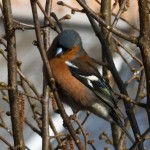 The top five birds seen last year were House Sparrow, Starling, Blackbird, Blue Tit and Chaffinch, although there were some unusual sightings including ravens, buzzards and red kites. Not unexpectedly the top five were similar in Northamptonshire, but with Woodpigeons pipping the Chaffinches for fifth spot. What I find interesting about the results is that there are some birds such as robins and blackbirds which were spotted in high percentages of gardens, even if the average number per garden was not very high (also possibly hindered in some cases by an inability to tell the males and females apart).
The top five birds seen last year were House Sparrow, Starling, Blackbird, Blue Tit and Chaffinch, although there were some unusual sightings including ravens, buzzards and red kites. Not unexpectedly the top five were similar in Northamptonshire, but with Woodpigeons pipping the Chaffinches for fifth spot. What I find interesting about the results is that there are some birds such as robins and blackbirds which were spotted in high percentages of gardens, even if the average number per garden was not very high (also possibly hindered in some cases by an inability to tell the males and females apart).
So, how do you take part? Simple. Choose one hour this weekend (28th / 29th January), I find mornings are normally better for bird activity, write a list of the birds that you are likely to see (include a line for male and females if you can tell them apart) settle back and count the birds that come into your garden. Be careful not to count them twice, only count the maximum number that you can see at any one time. Then, submit your sightings online at www.rspb.org.uk/birdwatchresults . You can also find a useful guide to help you identify birds on their website.
So, happy birdwatching and thank you for taking part in a wildlife survey.
Damselflies
At this time of year you may notice lots of damselflies zipping about. As far as I can tell these emerge from the pond earlier than dragonflies, and, who can blame them as they make a tasty meal for their voracious cousins.
The damselfly lays it eggs in or close to water and these hatch after about a month. The nymphs then remain in the pond for one to two years before crawling up a convenient piece of vegetation and emerging from their larval case (exuvia). I think we have had at least 10 emerge from our pond in the last month. Here’s a picture I caught of a damselfy as it was emerging.
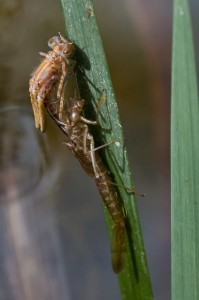 The damselfly then has to sit there as it pumps fluid to its wings and dries out before it can fly off. The time taken for this depends on the weather and one I was watching took about 3 hours in early May, but about half that time a couple of weeks later.
The damselfly then has to sit there as it pumps fluid to its wings and dries out before it can fly off. The time taken for this depends on the weather and one I was watching took about 3 hours in early May, but about half that time a couple of weeks later.
Damselflies are much smaller than dragonflies, and sit with their wings held in to their long slim body (thorax) unlike dragonflies which are much larger and wider and who hold their wider wings out.
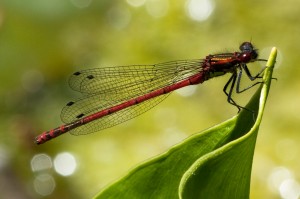
This is a large red damselfy (which I think is the species that emerged from the pond in early May). Unfortunately they only tend to live for a few weeks so enjoy them whilst you can. Can you think of a better reason to put a pond in your garden than to see these fantastic creatures close-up?
For a great introduction to dragonflies and damselflies see the Leicestershire and Rutland Dragonfly Group website.
Polecats are on the march (although I haven’t seen one).
Polecats are the latest mammal to be making a comeback in the UK. First of all it was otters, now it seems that polecats are increasing in number in the UK. Is this good news? I think so.
Until I read a recent article in the British Wildlife Magazine I didn’t know anything about polecats (or even realise they existed in the wild), so here are a few things I have learned:
They are native and were reduced to small groups surviving only in Wales, in no small part due to persecution by farmers and gamekeepers.
They are now spreading north and east, although their range appears to be limited by the major conurbations of the north-west and the midlands.
Polecats are relatives of ferrets, and there has been reduction in the purity of the polecate genes by some interbreeding with ferrets.
Polecats are about half a metre long (similar in size to ferrets), they have dark fur, lighter fur on their faces and dark noses (ferrets tend to have pink noses).
Unfortunately the polecats are often killed on the roads.
They manage better in the wild than ferrets as they are good hunters (ferrets were bred to be rubbish at catching their prey) and are thriving on the increased population of rabbits in the wild (currently standing around 45 million).
The good news is that it is thought that they (or possibly the otters) are having an adverse effect on mink which are starting to hunt during the day. So, in the world of doom and gloom with everything seeming to be labelled a ‘crisis’ it appears there is some good news out there (unless you are a rabbit, frog, ground nesting bird…Oops, I think I am going off them a bit!).
For more information about polecats see the report from the Vincent Wildife Trust or subscribe to the excellent British Wildlife Magazine.
Are you missing out on something this weekend?
In the UK a bank holiday weekend is approaching and who knows, maybe the weather will be warm and sunny. So, a nation will get into its cars and head to the coast or the national parks, spend a few hours in traffic jams, looking for somwhere to park, looking for somewhere to eat etc etc. But, what are you missing closer to home? This weekend is the perfect opportunity to go out and look closely at what nature has to show you (for free and without needing to sit in a metal box on a long, boring stretch of concrete).
I have a few suggestions to make, these are for those in the Daventry area, but I am sure there are similar things to be found wherever you live in the UK.
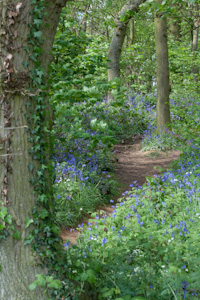
Firstly, at this time of the year the bluebells are a must. In Badby and Everdon there are cream teas available this weekend for those going to see one of nature’s most beautiful spectacles. I went to visit the bluebells in Badby Woods for the first time last year. Apart from the spectacle of a sea of blue in all directions, the scent is astonishing as is the constant drone of the bees. I went to Everdon Stubbs this week which is stunning at the moment, but I was later told is also somewhere to hear a cuckoo, something I think of as the quintessential rural England.
If you don’t want to go that far, how about a walk around the country park. At the moment the hobbies have returned and are swooping about at the far end of the dam, just in front of the trees, chasing larger insects and smaller birds. The swallows, house martins and swifts are also there, screaming about the water (being chased by hobbies!) as are the common terns, preparing to nest on the tern rafts and patrolling along the shallower waters looking for their lunch.
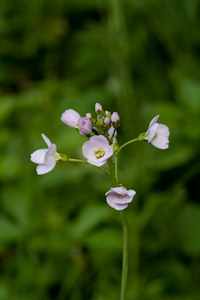
The hedgerows are starting to get their second coat of white – the hawthorn is coming into blossom. Along the ground around the edges of the housing estate, industrial estates and country park are an array of wild flowers. Cowslips are still in bloom, along with the more delicate Cuckoo Flower (also known as Ladies Smock) and, if you look closely you may notice the small purple blooms of the Ground Ivy. As always, darting above the flowers are the butterflies; Orange Tips, Large Whites and Speckled Woods are all there, waiting for you.
So, instead of trying to get away from it all, why not stay home in the midst of it all and relax!
First signs of Spring
The sun came out today, and for the first time this year there was a definite warmth to it. Along with the sun came the first of the season’s bumblebees.
These are the queen bees foraging for food before looking for a suitable nest site. Although much of the media’s attention has been on the plight of the honeybee (mainly due to the huge potential losses for commercial beekeepers), bumblebees also play a huge part in plant pollination. The fact that bumblebees do not stockpile honey for an overwintering colony has led to them being less recognised as an endangered species. In fact, according to Wikipedia, three of our native bumblebees have already become extinct and another six are in serious decline.
It is therefore of vital importance that we garden with bumblebees in mind and try to provide a range of plants that flower throughout the year, particularly in early spring when the queen bees are about. If you are stuck for ideas why not try the Bumblebee Conservation Trust’s website which lists a number of bee friendly plants. If you would like to add in some earlier flowering species why not plant some crocus and snowdrops in a sunny part of your garden, with sweet box (sarcocca confusa) and clematis armandii in shadier parts. Not only will you be helping the bees, but you will brighten your own day with the sight and scent of these early flower plants.
Is it too soon to say farewell to Summer?

I have been thinking recently that autumn was well on its way and I might as well say goodbye to Summer. The rose hips, particularly the rosa rugosa are now very red, the rowans are covered in red berries, during the week the sun gets up after I do (although there have been some days where I am think it may have stayed in bed) and the call of the chiffchaff has been replaced by the steady tic tic noise of the robin as I walk to work.
However, maybe I have been a bit hasty in this assumption. Yesterday, the Country Park was teeming with swallows, house martins and terns. OK, so maybe they are massing and preparing to be off, but they are not gone yet. Last week I was surprised to hear a chiffchaff calling as I walked to work, again, he may have been heading south, but it was still a reassuring noise.
Whilst the damp (understatement?) weather has brought some fungi out there are still some flowers at the roadsides and in the hedgerows, primarily achillea and white nettle-like flowers, but they are there nonetheless, providing an additional source of food for the bees which are still about in good-ish numbers whenever there is a letup in the rain.
Also at the Country Park yesterday, amidst the blackbirds and thrushes feeding on the glistening black elderberries were a pair of blackcaps – more Summer warblers that are still about. So, maybe the last observation doesn’t count, I have seen an increasing number of blackcaps overwintering around here, but they are still a bird that I primarily associate with Summer, and for now I am sticking with that thought!
